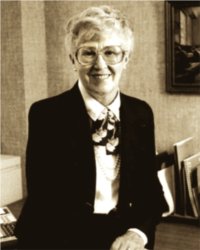Elizabeth Blackwell Award
LORETTA C. FORD

In the 1960s, Dr. Ford found pediatric health care in America woefully lacking. She created a model that combined clinical care and research to give Public Health Nurses the preparation necessary for them to help children and their families. Individuals who participated in this training became known as Pediatric Nurse Practitioners.
Ford has gone on to author more than 100 publications on the history of nurse practitioners, unification of practice and issues in advanced nursing practice. (See biography below for additional background.)
“Many have benefited from Dr. Ford’s vision and wisdom,” said Hobart and William Smith President Mark D. Gearan. “Scores of people now have access to enhanced health care that they might never have received had it not been for her foresight. Hobart and William Smith honor Dr. Ford for her pioneering spirit and drive.”
Biography
Ford, dean and professor emerita at the University of Rochester Schthe Founding Dean of the University of Rochester School of Nursing. She was charged andool of Nursing, is credited with enhancing health care of the general populous, and transforming the profession of nursing and enriching the lives of nurses. Finding pediatric health care in communities woefully lacking, Ford believed Public Health Nurses (PHN) with special child training could provide much needed health care. So, she set about creating a model that would combine clinical care and research to give nurses the preparation to help their small patients and their families. This model was the Pediatric Nurse Practitioner (PNP). PNPs served their patients taking into account their health status and their social, psychological, environmental and economic situations to produce safe, effective, economical and environmental preventive care.
Ford earned undergraduate and graduate degrees in nursing, a certificate in PHN and a doctorate in Education at the University of Colorado. As a PHN, Ford recognized the value of astute clinical decision making and the competence, confidence and authority that nurses needed to fulfill this role. In 1964, Ford collaborated with Dr. Henry K. Silver, a pediatrician at the University of Colorado Medical Center. Together, they devised an educational program for PHNs, focusing on well-child care, normal growth and development, family education and empowerment, and preventive health measures.
Upon national success of the program in 1972, Ford moved to the University of Rochester as
challenged to develop a Unification of Nursing Practice, Education, and Research with responsibilities for Nursing Education and Service as the Dean of the School and Director of the University Hospital's Nursing Service.
In 1979, Ford predicted that the Nurse Practitioner (NP) would become the Nurse for all settings, and that indeed has happened. NPs are a vital part and partner on the health team, serving patients of all ages and at all stages of living and dying, with all kinds of health needs, and in all settings around the world. The Nurse Practitioner has come of age.
